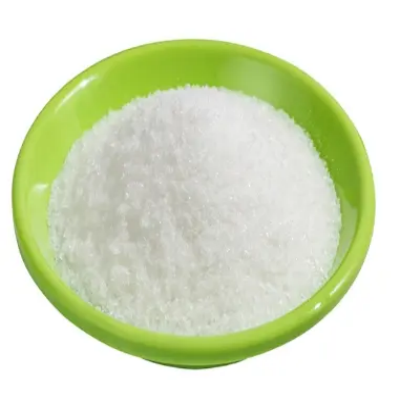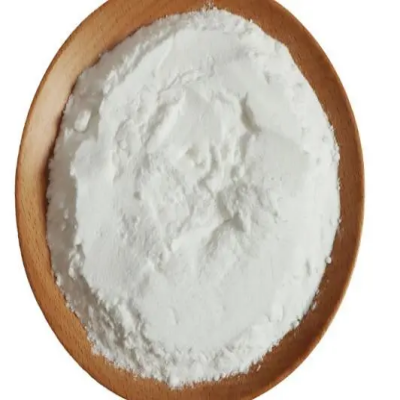-

Terbinafine base CAS:91161-71-6
Terbinafine base is an active pharmaceutical ingredient used to treat fungal infections. It belongs to the allylamine class of antifungals and is known for its effectiveness against dermatophytes, yeasts, and molds.
-

2-Chloro-4,6-dimethoxy-1,3,5-triazine CAS:3140-73-6
2-Chloro-4,6-dimethoxy-1,3,5-triazine is a chemical compound utilized as a versatile building block in organic synthesis and chemical modification processes. It features chloro and methoxy functional groups attached to a triazine ring structure, enabling its application in diverse chemical reactions and compound formations.
-

2-Amino-4,5-bis(2-methoxyethoxy)benzonitrile CAS:950596-58-4
2-Amino-4,5-bis(2-methoxyethoxy)benzonitrile is a chemical compound utilized in pharmaceutical research, characterized by a benzonitrile structure with amino and methoxyethoxy substitutions, potentially significant for specific therapeutic applications.
-

(1R)-(S)-pinanediol-1-Ammonium Trifluoroacetate-3-methlbutane-1-boronate CAS:179324-87-9
(1R)-(S)-Pinanediol-1-Ammonium Trifluoroacetate-3-Methylbutane-1-Boronate is a chemical compound characterized by a complex structure featuring a pinanediol backbone, an ammonium trifluoroacetate group, and a boronate ester functionality. It is utilized in organic synthesis as a chiral building block, enabling the creation of stereospecific compounds and pharmaceutical intermediates.
-

Diethyl L-glutamate hydrochloride CAS:1118-89-4
Diethyl L-glutamate hydrochloride is a chemical compound used primarily as a synthetic intermediate in pharmaceutical research and organic synthesis. It is derived from L-glutamic acid and serves as a precursor in the production of various pharmaceuticals and biologically active compounds.
-

3,3-Dimethyl-1-Butyne CAS:917-92-0
3,3-Dimethyl-1-butyne is a chemical compound notable for its triple bond structure and two methyl groups attached to the carbon atoms of the triple bond. It is commonly referred to as tetramethylethyne and is used in various chemical synthesis processes.
-

6-Chloro-3-methyluracil CAS:4318-56-3
6-Chloro-3-methyluracil is a derivative of uracil, a pyrimidine base, with chlorine and methyl groups attached to specific positions on the uracil ring. This modification imparts distinct chemical and biological properties to the compound, making it significant in medicinal chemistry and biochemical research. 6-Chloro-3-methyluracil’s structure influences its interactions within biological systems, particularly in nucleic acid synthesis and enzyme inhibition, which are critical aspects in drug design and therapeutic development.
-

4-Isothiocyanato-2-(trifluoromethyl)benzonitrile CAS:143782-23-4
4-Isothiocyanato-2-(trifluoromethyl)benzonitrile is a chemical compound characterized by an isothiocyanate functional group attached to a trifluoromethyl-substituted benzene ring. It is used primarily as a versatile building block in organic synthesis, enabling the creation of complex molecular structures and functional materials.
-
![Exit(1R,3R)-1-(1,3-Benzodioxol-5-yl)-2-(chloroacetyl-2,3,4,9-tetrahydro-1H-pyrido[3,4-b]indole-3-carboxylicacidmethyeste CAS:171489-59-1](https://cdn.globalso.com/xindaobiotech/5EVBWZZXL9LE4FA@55921.png)
Exit(1R,3R)-1-(1,3-Benzodioxol-5-yl)-2-(chloroacetyl-2,3,4,9-tetrahydro-1H-pyrido[3,4-b]indole-3-carboxylicacidmethyeste CAS:171489-59-1
(1R,3R)-1-(1,3-Benzodioxol-5-yl)-2-(chloroacetyl-2,3,4,9-tetrahydro-1H-pyrido[3,4-b]indole-3-carboxylic Acid Methyl Ester, abbreviated for clarity, is a chemical compound renowned for its intricate molecular architecture and potential applications in medicinal chemistry. This compound merges a pyridoindole core with a tetrahydrofuran ring fused to a chloroacetyl group and a 1,3-benzodioxol-5-yl moiety, featuring a methyl ester functionality. These structural elements provide avenues for diverse structural modifications and thorough biological investigations.
-

Candesartan ester intermediate C3 CAS:136285-65-9
Candesartan ester intermediate C3 is a pivotal compound in the synthesis of Candesartan cilexetil, a renowned angiotensin II receptor antagonist used primarily for treating hypertension and congestive heart failure. This intermediate plays a crucial role in the pharmaceutical industry due to its role as a precursor in the efficient synthesis of Candesartan cilexetil.
-

Linagliptin interMediate F CAS:853029-57-9
Linagliptin Intermediate F is a crucial intermediate in the synthesis of linagliptin, a potent dipeptidyl peptidase-4 (DPP-4) inhibitor used in the treatment of type 2 diabetes mellitus. This intermediate plays a pivotal role in the pharmaceutical industry due to its specific chemical structure and functionality. Linagliptin, known chemically as (R)-8-(3-aminopiperidin-1-yl)-7-(but-2-yn-1-yl)-3-methyl-1-(2,4,5-trifluorophenyl)-1,2-dihydroquinazolin-2(3H)-one, exerts its therapeutic effects by inhibiting DPP-4 enzyme activity, thereby enhancing the levels of incretin hormones like GLP-1 (glucagon-like peptide-1). This leads to improved glycemic control in patients with diabetes.
-

Candesartan Cilexetil Impurity 8 CAS:139481-28-0
Candesartan Cilexetil Impurity 8 is a byproduct that arises during the synthesis of Candesartan cilexetil, an angiotensin II receptor antagonist used primarily to manage hypertension and heart failure. Despite being unwanted in the final pharmaceutical formulation, understanding and controlling impurity profiles are crucial for ensuring product safety, efficacy, and regulatory compliance.

